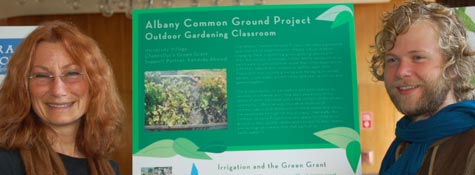UC Berkeley Press Release
|
'Thinking big' about energy, water, and waste
Student-organized Sustainability
Summit marks the growing maturity, and institutionalization, of
campus's greening movement
| 2008
Sustainability Award recipients
Student Laura Moreno for active contributions to campus sustainability since her freshman year. A founding member of the Green Room Committee and the Building Sustainability at Cal program, she is currently co-chair of the Chancellor's Advisory Committee on Sustainability (CACS). Faculty member Ashok Gadgil, a
senior research scientist at Lawrence Berkeley
Laboratory and an adjunct faculty member with
the campus's Energy & Resources
Group, for his work bringing to his teaching
his personal experiences with sustainability-related
projects in developing nations. 2008 Green Fund Grant recipients
|
BERKELEY — "We need to think big; we need to scale this up," Omar Khan said at UC Berkeley's fifth-annual Sustainability Summit, held on the eve of Earth Day. The Ph.D. student was describing the work of 15 students, through a climate-action course, to survey energy use in campus buildings and help address low-hanging fruit — like energy-hogging air-conditioning glitches and laboratory fume-hood sashes. (When a sash is left open, he noted, its exhaust fan consumes as much energy as three average houses — and there are 1,300 fume hoods across campus).
The growing maturity of environmentalism at UC Berkeley was evident at the April 21 summit, as participants reported on programs — the lion's share of them student initiated — to conserve resources, mitigate carbon footprint, and reduce waste. Some 500 to 600 summit participants also took stock of progress toward permanently incorporating sustainability concerns into the campus planning and operations — and identified unfinished work ahead.
Organized by the Chancellor's Advisory Committee on Sustainability (CACS), the day featured the announcement of the 2008 winners of the Green Fund Grants, supporting innovative campus sustainability projects, and the 2008 Sustainability Awards.
In a morning session in Pauley Ballroom, graduate student Sam Borgeson described a project made possible by a $2,000 Green Fund Grant, awarded last year to Design Students for a Sustainable Future. In Wurster Hall, he said, a mountain of design-studio materials abandoned at semester's end was a call to action. Participating students waded through the end-of-semester wreckage to sort and store wood, glues, paints, and other materials — for reclamation by any student who wants them the following semester.
Simple though labor-intensive, the program has diverted two to three tons of materials from the waste stream, he estimated, and offset as much as $10,000 of new purchases — while simultaneously "raising awareness of people who are going to go on to make much bigger decisions in the design and construction industry."
Two undergraduates gave an account of their daunting work-in-progress to find new homes for — rather than send to landfill — "unfathomable amounts of stuff" left in the eight-story state Department of Health Services building, in downtown Berkeley, when the campus acquired it as future site for the School of Public Health. Meanwhile, Judy Chess, a project manager in Capital Projects, reported on the progress toward incorporating sustainability criteria into campus remodeling, construction, and demolition projects. For the razing of Warren Hall, now in progress, a sorting machine is being used to separate out, for recycling, about 90 percent of the building's concrete steel. Similarly, a large percentage of the concrete from old Stanley Hall was salvaged, rather than discarded, when that building was demolished, she reported.
 Lamps from Wurster Hall design studios, sorted for reuse by cash-strapped students. |
Sophomores Lisa Veliz and Lindsey Sanders — participants in a pair of "Building Sustainability at Cal" participation-action courses — told of students' water, waste, and energy audits of nine campus buildings. (Trash found in an audit of University Hall on a single day in March: 42 pounds of mixed paper, 17 pounds of food waste, and 100 discarded paper cups.) For class members, they said, the ultimate goal is to so improve the systems and occupant habits of the targeted facilities that these buildings will eventually quality for certification under the U.S. Green Building Council's LEED certification program.
Attesting to the intensity of student interest in environmental responsibility and climate action, the summit was entirely organized and executed by students — from programmatic and food-catering details to the hand-made suggestion-box, fashioned (naturally) from recycled materials, on each luncheon table.


